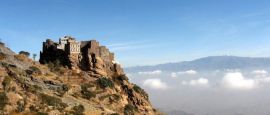Yemen Weather, climate and geography
Weather & climate
It’s generally accepted that the best time to visit Yemen and therefore the ‘high season’ falls between October and April, after the rains and before the intense heat of the summer. However, temperatures, humidity and rainfall all vary radically with altitude.
The southern coastal areas see limited rainfall and are hot and humid year round, summer temperatures sometimes topping 54°C (129°F).
The central highlands are hot in summer with average temperatures of 30°C (86°F), but winters are cold with frequent frosts. Average rainfall in the central highlands varies from 400mm to 750mm per year.
Northern regions, and Wadi Hadhramawt, are hot and dry year round. Summer temperatures hover around the high 30s and it’s not uncommon to find areas where it hasn’t rained for years. That said, Wadi Hadhramawt suffered severe floods in 2008 which threatened to engulf the ancient mud city of Shibam.
Geography
The Republic of Yemen is bordered in the northwest, north and northeast by Saudi Arabia, in the east by Oman and in the south by the Gulf of Aden. To the west lies the Red Sea. The islands of Perim and Karam in the southern Red Sea are also part of the Republic. Yemen is predominantly mountainous, supporting terraced agriculture. The Hadramaut is a range of high mountains in the centre of the country. Highlands rise steeply in central Yemen, ranging in height from approximately 200m (656ft) to the 4,000m (13,123ft) peak of Jabal Nabi Shauib. In contrast is Tihama, a flat semi-desert coastal plain to the west, 50 to 100km (30 to 60 miles) wide. Surface water flows down from the mountains through the valleys during the rainy season and the area is cultivated for cotton and grain. In the east, the mountains drop away to the Rub al-Khali or 'Empty Quarter' of the Arabian Peninsula, a vast sea of sand. The arid coastal plains are fringed with sandy beaches.
Do you have any Feedback about this page?
© 2026 Columbus Travel Media Ltd. All rights reserved. No part of this site may be reproduced without our written permission, click here for information on Columbus Content Solutions.




 You know where
You know where